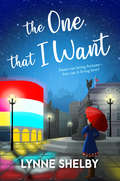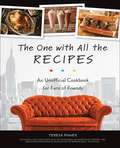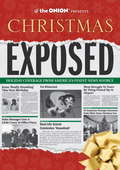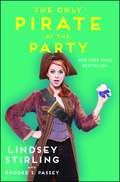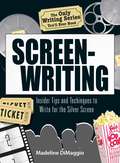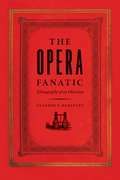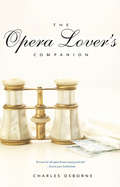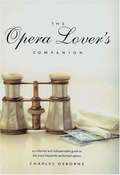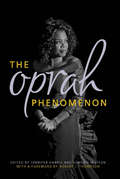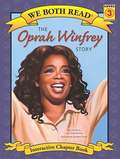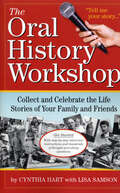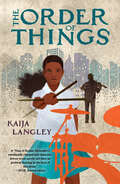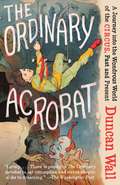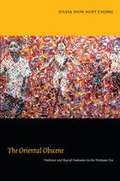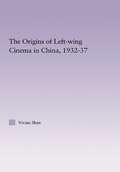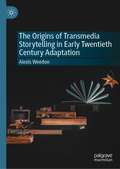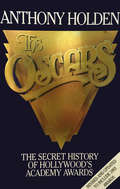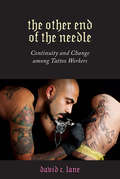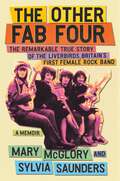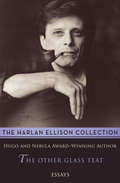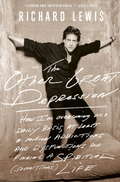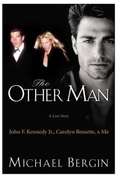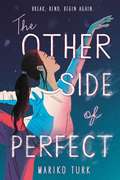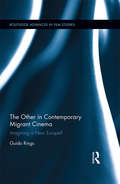- Table View
- List View
The One That I Want: The Theatreland Series (The Theatreland Series #1)
by Lynne ShelbyFame can bring fortune - but can it bring love?'Warm-hearted, romantic, and beautifully written' KATE FIELD, author of A Place to Begin AgainWhen Lucy Ashford lands a top job at a leading theatrical agency in London, work mixes with pleasure, as she literally falls into the arms of Hollywood heartthrob Daniel Miller.Handsome, charming and irresistible, Daniel is just what unlucky-in-love Lucy needs, and she is quickly drawn into his glittering celebrity lifestyle. But can she tame the A-list bad boy or is she just one more girl in Daniel s long line of conquests?And then there's up-and-coming actor Owen Somers, fiercely talented but as yet uncast in a starring role. After she takes him onto the agency's books, Owen and Lucy's friendship slowly grows. If she looks closely, Lucy's leading man might be right before her very eyes...________Readers LOVE Lynne's swoon-worthy romances:'Well this is a wonderfully, romantic story! This is the first book I have read by Ms Shelby and I thoroughly enjoyed it, and I am looking forward to reading more from this talented author. The One That I Want is fun, entertaining and very romantic' Amazon reviewer'Shelby's writing style transports you so completely into the world of her characters that I actually dreamt about Owen Somers! I loved reading this book and found it to be the perfect balance of romantic, unpredictable and fast paced. I really didn't want it to end' Amazon reviewer'This was a perfect weekend read. It whisked me away from rainy reality to the glamorous celebrity world in London... The story raced along with plenty of twists and turns; I had no idea how it was going to end, or which way I wanted it to end. Warm-hearted, romantic and beautifully written - I loved it' Amazon reviewer'Lynne Shelby has given us a glamorous, fun and compulsive read in her fabulous The One That I Want. I was rooting for the heroine Lucy all the way through and enjoyed every twist and turn of the plot... I thoroughly recommend this fresh, sparkling book - it's the one that you want!' Amazon reviewer'A believable and fun escape into the world of celebrity and showbiz... Very enjoyable read, with a most satisfactory ending' Amazon reviewer'A very well told story, of things that glitter brightly , but are rarely gold. Lovely believable charters with a good dollop of romance' Amazon reviewer'I really enjoyed this book. Lovely characters, lovely story and very well written. I will buy more books by this author' Amazon reviewer
The One with All the Recipes: An Unofficial Cookbook for Fans of Friends
by Teresa FinneyCould this BE any more delicious?You&’re the ultimate fan of Friends. You&’ve seen every episode (multiple times). You get all the inside jokes. You even know how to make that trifle. But with this fun and funny cookbook, you can take your fandom one step further by whipping up incredible entrées inspired by this iconic 1990s sitcom. You know one person who doesn&’t share food, but you can share yours! This cookbook is packed with delicious recipes that are perfect for you and your own friends to enjoy together. Whether it&’s a going away party when you move to Yemen, a Friendsgiving dinner in your unaffordable NYC apartment, or just having some nibbles during a binge viewing party, The One with All the Recipes will be there for you with: • Not-So-Fine Margaritas • Engagement Ring Lasagna • &“French Aunt&” Chocolate Chip Cookies • Thanksgiving Turkey for One • Fried Stuff with Cheese • Perfect Pox Peach CobblerIf you're a fan of cookbooks such as Bob's Burgers, Game of Scones, or the Gilmore Girls Eat Like a Gilmore, you'll love this ultimate tribute to the greatest sitcom ever written!
The Onion Presents: Christmas Exposed
by The Onion StaffChristmas wouldn't be Christmas without impulse-priced holiday gift books--and now The Onion has unleashed its award-winning team of investigative journalists upon the genre. Christmas Exposed features more than one hundred shocking tales of Secret Santas, shopping mall mayhem, dysfunctional family dinners, and much, much more.From the Trade Paperback edition.
The Only Pirate at the Party
by Brooke S. Passey Lindsey StirlingDancing electronic violinist Lindsey Stirling shares her unconventional journey in an inspiring New York Times bestselling memoir filled with the energy, persistence, and humor that have helped her successfully pursue a passion outside the box.A classically trained musician gone rogue, Lindsey Stirling is the epitome of independent, millennial-defined success: after being voted off the set of America’s Got Talent, she went on to amass more than ten million social media fans, record two full-length albums, release multiple hits with billions of YouTube views, and to tour sold-out venues across the world. Lindsey is not afraid to be herself. In fact, it’s her confidence and individuality that have propelled her into the spotlight. But the road hasn’t been easy. After being rejected by talent scouts, music reps, and eventually on national television, Lindsey forged her own path, step by step. Detailing every trial and triumph she has experienced until now, Lindsey shares stories of her humble yet charmed childhood, humorous adolescence, life as a struggling musician, personal struggles with anorexia, and finally, success as a world-class entertainer. Lindsey’s magnetizing story—at once remarkable and universal—is a testimony that there is no singular recipe for success, and despite what people may say, sometimes it’s okay to be The Only Pirate at the Party.
The Only Writing Series You'll Ever Need: Insider Tips and Techniques to Write for the Silver Screen!
by Madeline DiMaggioThe insider info you need!Writing scripts for the big screen takes more than a big idea--it requires passion, perseverance, and insider know-how. The Only Writing Series You'll Ever Need: Screenwriting is your go-to resource for mastering the complete screenwriting process. Taking you step by step from idea to deal, you'll learn how to:Write a sellable scriptCreate real and credible dialogFind an agent and market the script the right wayEdit and revise--over and over and over againLive the life of a full-time screenwriterIdeal for those writers who want to perfect their craft and shop their script around, The Only Writing Series You'll Ever Need: Screenwriting is your break into this exciting career!
The Opera Fanatic: Ethnography of an Obsession
by Claudio E. BenzecryThough some dismiss opera as old-fashioned, it shows no sign of disappearing from the world’s stage. So why do audiences continue to flock to it? Given its association with wealth, one might imagine that opera tickets function as a status symbol. But while a desire to hobnob with the upper crust might motivate the occasional operagoer, for hardcore fans the real answer, according to The Opera Fanatic, is passion—they do it for love. Opera lovers are an intense lot, Claudio E. Benzecry discovers in his look at the fanatics who haunt the legendary Colón Opera House in Buenos Aires, a key site for opera’s globalization. Listening to the fans and their stories, Benzecry hears of two-hundred-mile trips for performances and nightlong camp-outs for tickets, while others testify to a particular opera’s power to move them—whether to song or to tears—no matter how many times they have seen it before. Drawing on his insightful analysis of these acts of love, Benzecry proposes new ways of thinking about people’s relationship to art and shows how, far from merely enhancing aspects of everyday life, art allows us to transcend it.
The Opera Lover's Companion
by Charles OsborneThis engaging guide to the 175 most popular operas will enhance the experience of every opera lover. Written by a well-known authority, the book consists of entries that set each opera within the context of its composer's career, outline the plot, discuss the music, and give relevant background information on the libretto, the staging, and the most famous and influential interpreters of the principal roles. In addition, the entries recount details of the first performance and subsequent performance history and provide guidance on the relative quality of available recordings. Aimed at opera lovers and committed newcomers rather than specialists, The Opera-Lover's Companion does not set out to cover every opera but only those most frequently encountered in opera houses or on recordings. Although the book is dominated by the five great opera composers-Mozart, Verdi, Wagner, Puccini, and Strauss-fifty-eight other composers are also represented. It is always more pleasurable to go to the opera with a knowledgeable and experienced companion. If you can't, you'll want to take this book.
The Opera Lover's Companion
by Charles OsborneThis engaging guide to the 175 most popular operas will enhance the experience of every opera lover. Written by a well-known authority, the book consists of entries that set each opera within the context of its composer's career, outline the plot, discuss the music, and give relevant background information on the libretto, the staging, and the most famous and influential interpreters of the principal roles. In addition, the entries recount details of the first performance and subsequent performance history and provide guidance on the relative quality of available recordings. Aimed at opera lovers and committed newcomers rather than specialists,The Opera-Lover's Companiondoesnot set out to cover every opera but only those most frequently encountered in opera houses or on recordings. Although the book is dominated by the five great opera composers--Mozart, Verdi, Wagner, Puccini, and Strauss--fifty-eight other composers are also represented. It is always more pleasurable to go to the opera with a knowledgeable and experienced companion. If you can't, you'll want to take this book.
The Oprah Phenomenon
by Jennifer Harris and Elwood Watson&“Excellent essays&” on a business empire, a cultural phenomenon, and the nature of the extraordinary bond between Oprah Winfrey and her fans (Journal of Social History). Oprah Winfrey has built an empire on her ability to connect with and inspire her audience. No longer just a name, &“Oprah&” has become a brand representing a unique style of self-actualizing individualism. The cultural and economic power wielded by Winfrey merits critical evaluation. The contributors to The Oprah Phenomenon examine the origins of her public image and its substantial influence on politics, entertainment, and popular opinion. Contributors address praise from her supporters and weigh criticisms from her detractors. Winfrey&’s ability to create a feeling of intimacy with her audience has long been cited as a foundation of her popularity. She has made headlines by engaging and informing her audience with respect to her personal relationships to race, gender, feminism, and New Age culture. The Oprah Phenomenon explores these relationships in detail. At the root of Winfrey&’s message is her assertion that anyone can be a success regardless of background or upbringing. The contributors scrutinize this message: What does this success entail? Is the motivation behind self-actualization, in fact, merely the hope of replicating Winfrey&’s purchasing power? Is it just a prescription to buy the products she recommends and heed the advice of people she admires, or is it a lifestyle change of meaningful spiritual benefit? The Oprah Phenomenon asks these and many other difficult questions to promote a greater understanding of Winfrey&’s influence on the American consciousness. &“Identifies the common threads that run through Oprah&’s empire, the demographics of her audience, how she brings together women of diverse backgrounds, and her use of empathy and encouragement to foster self-improvement.&” ―Library Journal With a foreword by Robert J. Thompson
The Oprah Winfrey Story (We Both Read)
by Sindy Mckay Lisa MariaOprah Winfrey was born into poverty and struggled with a very difficult and troubled life as a young girl. Yet, Oprah has become one of the most influential people in the world, inspiring millions to create a better life for themselves and others. The story of her life is a powerful reminder of how dreams can be realized through determination, perseverance, and the kindness of a helping hand.
The Oral History Workshop: Collect and Celebrate the Life Stories of Your Family and Friends
by Lisa Samson Cynthia HartWe all know that we should ask now, before it's too late, before the stories are gone forever. But knowing and doing are two different things.Cynthia Hart, author of Cynthia Hart's Scrapbook Workshop, shows exactly how to collect, record, share, and preserve a family member's or a friend's oral history in this practical and inspirational guide. The Oral History Workshop breaks down what too often feels like an overwhelming project into a series of easily manageable steps: how to prepare for an interview; how to become a better listener; why there's always more beneath the surface and the questions to ask to get there; the pros and cons of video recording, including how your subjects should dress so the focus is on their words; four steps to keeping the interview on track; how to be attentive to your subject's energy levels; and the art of archiving or scrapbooking the interview into a finished keepsake.At the heart of the book are hundreds of questions designed to cover every aspect of your subject's history: Do you remember when and how you learned to read? Who in your life showed you the most kindness? What insights have you gained about your parents over the years? Would you describe yourself as an optimist or a pessimist? In what ways were you introduced to music? What is the first gift you remember giving? If you could hold on to one memory forever, what would it be? When the answers are pieced together, a mosaic appears—a living history.
The Order of Things
by Kaija LangleyA heart-rending novel-in-verse about a girl beginning to learn it is possible to go on even after a great loss.Eleven-year-old April Jackson loves playing the drums, almost as much as she loves her best friend, Zee, a violin prodigy. They both dream of becoming professional musicians one day. When Zee starts attending a new school that will nurture his talent, April decides it&’s time for her to pursue her dreams, too, and finally take drum lessons. She knows she isn&’t very good to start, but with Zee&’s support, she also knows someday she can be just as good as her hero, Sheila E., and travel all around the world with a pair of drumsticks in her hand.When the unthinkable happens and Zee suddenly passes away, April is crushed by grief. Without Zee, nothing is the way it&’s supposed to be. Zee's Dad isn't delivering the mail for his postal route like he should. April's Mom is suddenly dating someone new who is occupying too much space in their lives. And every time April tries to play the drums, all she can think about is Zee.April isn't sure how to move on from the awful feeling of being without Zee. Desperate to help Papa Zee, she decides to secretly deliver the mail he&’s been neglecting. But when on her route she discovers a classmate in trouble, she doesn&’t second guess what she knows is the right thing to do.
The Ordinary Acrobat: A Journey into the Wondrous World of the Circus, Past and Present
by Duncan WallThe extraordinary story of a young man's plunge into the unique and wonderful world of the circus--taking readers deep into circus history and its renaissance as a contemporary art form, and behind the (tented) walls of France's most prestigious circus school. When Duncan Wall visited his first nouveau cirque as a college student in Paris, everything about it--the monochromatic costumes, the acrobat singing Simon and Garfunkel, the juggler reciting Proust--was captivating. Soon he was waiting outside stage doors, eagerly chatting with the stars, and attending circuses two or three nights a week. So great was his enthusiasm that a year later he applied on a whim to the training program at the École Nationale des Arts du Cirque--and was, to his surprise, accepted. Sometimes scary and often funny, The Ordinary Acrobat follows the (occasionally literal) collision of one American novice and a host of gifted international students in a rigorous regimen of tumbling, trapeze, juggling, and clowning. Along the way, Wall introduces readers to all the ambition, beauty, and thrills of the circus's long history: from hardscrabble beginnings to Gilded Age treasures, and from twentieth-century artistic and economic struggles to its brilliant reemergence in the form of contemporary circus (most prominently through Cirque du Soleil). Readers meet figures past--the father of the circus, Philip Astley; the larger-than-life P. T. Barnum--and present, as Wall seeks lessons from innovative masters including juggler Jérôme Thomas and clown André Riot-Sarcey. As Wall learns, not everyone is destined to run away with the circus--but the institution fascinates just the same. Brimming with surprises, outsized personalities, and plenty of charm, The Ordinary Acrobat delivers all the excitement and pleasure of the circus ring itself.
The Oriental Obscene: Violence and Racial Fantasies in the Vietnam Era
by Sylvia Shin ChongThe Oriental Obscene is a sophisticated analysis of Americans' reactions to visual representations of the Vietnam War, such as the photograph of the "napalm girl," news footage of the Tet Offensive, and feature films from The Deer Hunter to Rambo: First Blood Part II. Sylvia Shin Huey Chong combines psychoanalytic and film theories with U.S. cultural history to explain what she terms the oriental obscene: racialized fantasies that Americans derived largely from images of Asians as the perpetrators or victims of extreme violence. Chong contends that these fantasies helped Americans to process the trauma of the Vietnam War, as well as the growth of the Asian American population after the Immigration and Nationality Act of 1965 and the postwar immigration of Southeast Asian refugees. The oriental obscene animated a wide range of political narratives, not only the movements for and against the war, but causes as diverse as the Black Power movement, law-and-order conservatism, second-wave feminism, and the nascent Asian American movement. During the Vietnam era, pictures of Asian bodies were used to make sense of race, violence, and America's identity at home and abroad.
The Origins of Leftwing Cinema in China, 1932-37 (East Asia: History, Politics, Sociology and Culture)
by Vivian ShenThis book takes a cultural studies approach to analyze and account for the ways in which related to film, literature, cultural production, ideology, social change and modernity were in raised in the leftwing film movement of the 1930s.
The Origins of Transmedia Storytelling in Early Twentieth Century Adaptation
by Alexis WeedonThis book explores the significance of professional writers and their role in developing British storytelling in the 1920s and 1930s, and their influence on the poetics of today’s transmedia storytelling. Modern techniques can be traced back to the early twentieth century when film, radio and television provided professional writers with new formats and revenue streams for their fiction. The book explores the contribution of four British authors, household names in their day, who adapted work for film, television and radio. Although celebrities between the wars, Clemence Dane, G.B. Stern, Hugh Walpole and A.E.W Mason have fallen from view. The popular playwright Dane, witty novelist Stern and raconteur Walpole have been marginalised for being German, Jewish, female or gay and Mason’s contribution to film has been overlooked also. It argues that these and other vocational authors should be reassessed for their contribution to new media forms of storytelling. The book makes a significant contribution in the fields of media studies, adaptation studies, and the literary middlebrow.
The Oscars
by Anthony HoldenIt is just thirteen inches tall and weighs eight pounds, yet the Oscar has come to exert an hypnotic hold over film performers and audiences alike. This book uses the narrative story of an individual year as the basis of a much broader and historical canvas, to present a portrait of the film world today, and its personalities, finances and power-struggles. It also includes detailed lists of Oscar facts and figures, winners and losers. The author's other books include best-selling biographies of Prince Charles and Laurence Olivier.
The Oscars
by Anthony HoldenIt is just thirteen inches tall and weighs eight pounds, yet the Oscar has come to exert an hypnotic hold over film performers and audiences alike. This book uses the narrative story of an individual year as the basis of a much broader and historical canvas, to present a portrait of the film world today, and its personalities, finances and power-struggles. It also includes detailed lists of Oscar facts and figures, winners and losers. The author's other books include best-selling biographies of Prince Charles and Laurence Olivier.
The Other End of the Needle: Continuity and Change among Tattoo Workers (Inequality at Work: Perspectives on Race, Gender, Class, and Labor)
by David C. LaneThe Other End of the Needle demonstrates that tattooing is more complex than simply the tattoos that people wear. Using qualitative data and an accessible writing style, sociologist Dave Lane explains the complexity of tattoo work as a type of social activity. His central argument is that tattooing is a social world, where people must be socialized, manage a system of stratification, create spaces conducive for labor, develop sets of beliefs and values, struggle to retain control over their tools, and contend with changes that in turn affect their labor. Earlier research has examined tattoos and their meanings. Yet, Lane notes, prior research has focused almost exclusively on the tattoos—the outcome of an intricate social process—and have ignored the significance of tattoo workers themselves. "Tattooists," as Lane dubs them, make decisions, but they work within a social world that constrains and shapes the outcome of their labor—the tattoo. The goal of this book is to help readers understand the world of tattoo work as an intricate and nuanced form of work. Lane ultimately asks new questions about the social processes occurring prior to the tattoo’s existence.
The Other Fab Four: The Remarkable True Story of the Liverbirds, Britain's First Female Rock Band
by Mary McGlory Sylvia SaundersFor readers of Sheila Weller&’s Girls Like Us comes a fiercely feminist, heartwarming story of friendship and music about The Liverbirds, Britain&’s first all-female rock group. The idea for Britain&’s first female rock band, The Liverbirds, started one evening in 1962, when Mary McGlory, then age 16, saw The Beatles play live at The Cavern Club in Liverpool, the nightclub famously known as the &“cradle of British pop music.&” Then and there, she decided she was going to be just like them—and be the first girl to do it. Joining ranks in 1963 with three other working-class girls from Liverpool—drummer Sylvia Saunders and guitarists Valerie Gell and Pamela Birch, also self-taught musicians determined to &“break the male monopoly of the beat world&”—The Liverbirds went on to tour alongside the Rolling Stones, the Kinks, and Chuck Berry, and were on track to hit international stardom—until life intervened, and the group was forced to disband just five years after forming in 1968. Now, Mary and Sylvia, the band&’s two surviving members, are ready to tell their stories. From that fateful night in 1962, when Mary, who once aspired to become a nun, decided to provide for her family by becoming a rich-and-famous rocker, to the circumstances that led to the band splitting up—Sylvia&’s dangerously complicated pregnancy, and the tragic accident that paralyzed Valerie&’s beau—The Liverbirds tackles family, friendship, addiction, aging, and the forces—even destiny—that initially brought the four women together.
The Other Glass Teat: Essays
by Harlan EllisonIn the late 1960s, Harlan Ellison launched a weekly column for the Los Angeles Free Press, where he uncompromisingly discussed the effects of television on modern society. He assaulted everything from television sitcoms to corrupt politicians, talk shows to military massacres. Today, more than four decades later, almost all of his criticism still holds true. Open Road and Edgeworks Abbey, Ellison's company, are proud to make this second volume of fifty-two outspoken columns widely available.
The Other Great Depression: How I'm overcoming, on a daily basis, at least a million addictions and disfunctions and finding a s
by Richard LewisA new edition?now with a new Afterword?of the honest and hilarious recovery memoir by the famously neurotic comedian and regular guest star of the hit show "Curb Your Enthusiasm"
The Other Man: A Love Story - John F. Kennedy Jr., Carolyn Bessette, and Me
by Michael BerginNow, for the first time, Michael Bergin reveals the truth behind a life lived in the limelight and a relationship shrouded in secrecy. From his early days growing up in a small blue-collar Connecticut town, to his meteoric rise as fashion icon and television star, to the passion he shared with the enigmatic and complex Carolyn Bessette, this is an inside look at the world of beauty, power, and celebrity. In 1992, Michael and Carolyn met in a bar in New York City. She was unlike any woman he had ever known - sophisticated, successful, with bewitching grace. An intensely passionate relationship was born. Not long after, Michael landed the coveted Calvin Klein underwear campaign, and his career took off. The future looked bright, and Carolyn and Michael seemed destined for a long and happy life together. But it was not to be. Four years later Michael was an international fashion icon and Carolyn was Mrs. John F. Kennedy Jr. - however, the story doesn't end there. This is the truth about their lives, a tale full of warmth, humor, heartbreak, and tragedy. Above all, The Other Man is a testament to the enduring power of love and a story about the painful choices we make with our all-too-human hearts.
The Other Side of Perfect
by Mariko TurkFor fans of Sarah Dessen and Mary H.K. Choi, this lyrical and emotionally driven novel follows Alina, a young aspiring dancer who suffers a devastating injury and must face a world without ballet—as well as the darker side of her former dream. Alina Keeler was destined to dance, but then a terrifying fall shatters her leg—and her dreams of a professional ballet career along with it.After a summer healing (translation: eating vast amounts of Cool Ranch Doritos and binging ballet videos on YouTube), she is forced to trade her pre-professional dance classes for normal high school, where she reluctantly joins the school musical. However, rehearsals offer more than she expected—namely Jude, her annoyingly attractive castmate she just might be falling for.But to move forward, Alina must make peace with her past and face the racism she experienced in the dance industry. She wonders what it means to yearn for ballet—something so beautiful, yet so broken. And as broken as she feels, can she ever open her heart to someone else?Touching, romantic, and peppered with humor, this debut novel explores the tenuousness of perfectionism, the possibilities of change, and the importance of raising your voice.
The Other in Contemporary Migrant Cinema: Imagining a New Europe? (Routledge Advances in Film Studies #46)
by Guido RingsAs a rapidly aging continent, Europe increasingly depends on the successful integration of migrants. Unfortunately, contemporary political and media discourses observe and frequently also support the development of nationalist, eurosceptic and xenophobic reactions to immigration and growing multiethnicity. Confronting this trend, European cinema has developed and disseminated new transcultural and postcolonial alternatives that might help to improve integration and community cohesion in Europe, and this book investigates these alternatives in order to identify examples of good practices that can enhance European stability. While the cinematic spectrum is as wide and open as most notions of Europeanness, the films examined share a fundamental interest in the Other. In this qualitative film analysis approach, particular consideration is given to British, French, German, and Spanish productions, and a comparison of multiethnic conviviality in Chicano cinema.
